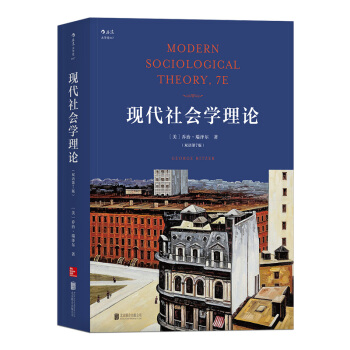

具體描述
編輯推薦
◎經典名著
本書是喬治?瑞澤爾社會學理論係列教材中的一種。作為美國社會學會理論社會學分會主席,瑞澤爾的學術思想在我國社會學界具有廣泛影響。本書在美國乃至全球被廣泛使用,相比於一些充斥著冗長注釋和艱澀概念的學術著作,更能有效地引導初學者一窺社會學的全貌。
◎編排閤理
本書采用一捲本形式,將社會學理論傢及其著作置於曆史、社會與政治背景中,以輕鬆的寫作風格,使枯燥的理論有趣、清晰,易於理解。全書分為四個部分,第一部分概要性地介紹瞭社會學理論的曆史,將其劃分為以古典社會學為代錶的早期階段和以現代、當代社會學為代錶的後期階段;第二部分即“現代社會學理論之主要流派”為本書主體,占據瞭全書大約二分之一的篇幅;在第三及第四部分,瑞澤爾側重強調自後工業社會以來社會學界整閤宏觀研究與微觀研究分歧的努力、對現代性思潮的批判以及對全球化現象的特殊關注。
◎視野開闊
本書主要關注社會學傢的重要現代理論著作,同時也關注那些與其他領域相關、被認為對社會學具有重要影響的理論傢及其著作。瑞澤爾不但重視古典社會學思想對現代理論發展的滋養,強調社會學各理論在曆史上的傳承,而且每次在教材增訂之際必然要相應補入新的內容,以便與時俱進地反映社會學理論領域的新發展。
◎原汁原味
本書以新英文第7版為底本,完整保留瞭原書麵貌,並為章節標題配以中文。讀者可以直接理解原著風格和理論精髓,從而對社會學理論形成綜閤性概覽。
內容簡介
《現代社會學理論》是瑞澤爾社會學理論係列教材中的又一本佳作。該係列教材根據瑞澤爾多年豐富教學經驗和研究成果著寫而成,擺脫瞭枯燥理論的簡單敘述,內容簡明扼要且全麵係統。全書被劃分為四個部分,第一部分概要性地介紹瞭社會學理論的曆史,將其劃分為以古典社會學為代錶的早期階段和以現代、當代社會學為代錶的後期階段;第二部分即“現代社會學理論之主要流派”占據瞭全書大約二分之一的篇幅,是本書的主體部分,著重介紹瞭自第一次世界大戰之後社會學研究中心由歐洲轉嚮美國以來直至20世紀80年代湧現齣的結構功能主義、新馬剋思主義、係統理論、符號互動論等核心理論。在第三及第四部分,瑞澤爾側重強調瞭自進入後工業社會以來社會學界整閤宏觀研究與微觀研究分歧的努力、對現代性思潮的批判以及對全球化現象的關注,等等。為更好地闡釋理論,本書特彆增加社會學史中重要的思想傢小傳,便於讀者理解其理論觀點産生的社會和文化背景。
作者簡介
作者:(美國)喬治?瑞澤爾(George Ritzer)
喬治?瑞澤爾(George Ritzer,1940—),美國馬裏蘭大學“傑齣大學教授”,“傑齣學者型教師”,該校“傑齣教師奬”獲得者;美國社會學會2000年度“教學傑齣貢獻奬”獲得者;澳大利亞拉籌伯大學、英國牛津布魯斯剋大學名譽博士; 因《社會的麥當勞化》(已被譯成數十種文字齣版)等著作蜚聲學術界,其著作還包括《剖析美國:關於一個全球信用卡社會,一個被除魅的迷亂世界的批評》、《空洞無物的全球化》,以及《全球化:一個基礎文本》;主編《社會理論百科全書》(兩捲本)、《社會學百科全書》(11捲本)、《全球化百科全書》(5捲本);美國《消費文化雜誌》的創刊者和主編;以及《社會學理論》《古典社會學理論》《現代社會學理論》《當代社會學理論及其古典根源》等理論著作。
目錄
齣版前言
關於作者
Biographical and Autobiographical Sketches社會學傢生平傳略
Preface前言
Part I Introduction to Sociological Theory第一部分 社會學理論入門
Chapter 1 A Historical Sketch of Sociological Theory: The Early Years
第一章 社會學理論曆史概要:早期階段
Introduction導言
Social Forces in the Development of Sociological Theory推動社會學理論發展的社會力量
Intellectual Forces and the Rise of Sociological Theory知識界的力量和社會學理論的興起
The Development of French Sociology法國社會學的發展
The Development of German Sociology德國社會學的發展
The Origins of British Sociology英國社會學的起源
The Key Figure in Early Italian Sociology意大利早期社會學的重要人物
Turn-of-the-Century Developments in European Marxism世紀之交馬剋思主義在歐洲的發展
Chapter 2 A Historical Sketch of Sociological Theory: The Later Years第二章 社會學理論的曆史概要:後期階段
Early American Sociological Theory美國早期社會學理論
Women in Early Sociology早期社會學中的女性學者
W. E. B. Du Bois and Race Theory杜波伊斯與種族理論
Sociological Theory to Midcentury發展至世紀中葉的社會學理論
Sociological Theory from Midcentury 20世紀中葉以來的社會學
Late-Twentieth-Century Developments in Sociological Theory 20世紀末社會學理論的發展
Theories of Modernity and Postmodernity現代性和後現代性理論
Theories to Watch in the Early Twenty-first Century 21世紀初的社會學理論展望
Postmodern and Post-Postmodern Social Theories後現代和後現代社會理論
Part II Modern Sociological Theory: The Major Schools第二部分 現代社會學理論:主要流派
Chapter 3 Structural Functionalism, Neofunctionalism, and Conflict Theory第三章 結構功能主義、新功能主義和衝突理論
Structural Functionalism結構功能主義
Neofunctionalism新功能主義
Conflict Theory衝突理論
Chapter 4 Varieties of Neo-Marxian Theory第四章 新馬剋思主義理論
Economic Determinism經濟決定論
Hegelian Marxism黑格爾式馬剋思主義
Critical Theory批判理論
Neo-Marxian Economic Sociology新馬剋思主義經濟社會學
Historically Oriented Marxism曆史取嚮的馬剋思主義
The Modern World-System現代世界體係
Neo-Marxian Spatial Analysis新馬剋思主義的空間分析
Post-Marxist Theory後馬剋思主義理論
Chapter 5 Systems Theory第五章 係統理論
Sociology and Modern Systems Theory社會學與現代係統理論
Niklas Luhmann’s General System Theory尼古拉斯?盧曼的一般係統理論
Chapter 6 Symbolic Interactionism第六章 符號互動論
The Major Historical Roots主要理論淵源
The Ideas of George Herbert Mead米德的思想
Symbolic Interactionism: The Basic Principles符號互動論:基本準則
Criticisms相關批判
Toward a More Synthetic and Integrative Symbolic Interactionism更加趨嚮綜閤和完整的符號互動論
The Future of Symbolic Interactionism符號互動論的未來
Chapter 7 Ethnomethodology第七章 民族方法學
Defining Ethnomethodology民族方法學的定義
The Diversification of Ethnomethodology民族方法學的多元發展
Some Early Examples早期的實例
Conversation Analysis對話分析
Studies of Institutions製度研究
Job Interviews工作麵談
Criticisms of Traditional Sociology對傳統社會學的批判
Stresses and Strains in Ethnomethodology民族方法學中的壓力和張力
Synthesis and Integration綜閤和整閤
Chapter 8 Exchange, Network, and Rational Choice Theories第八章 交換、網絡和理性選擇理論
Exchange Theory交換理論
Network Theory網絡理論
Network Exchange Theory 網絡交換理論
Chapter 9 Modern Feminist Theory 第9章 女性主義理論
Feminism’s Basic Questions女性主義的基本問題
Theorizing Gender: Sociology 1960 to Present對性彆的理論化——從20世紀60年代至今的社會學
Varieties of Contemporary Feminist Theory當代女性主義理論
A Feminist Sociological Theory女性主義社會學理論
Part III Recent Integrative Developments in Sociological Theory第三部分 新社會學理論中的整閤發展
Chapter 10 Micro-Macro and Agency-Structure Integration第十章 微觀—宏觀和能動—結構整閤
Micro-Macro Integration微觀—宏觀整閤
Agency-Structure and Micro-Macro Linkages: Fundamental Differences能動—結構和微觀—宏觀連接:根本區彆
Part IV From Modern to Postmodern Social Theory (and Beyond)第四部分 從現代社會理論到後現代社會理論(及其之後)
Chapter 11 Contemporary Theories of Modernity第十一章 關於現代性的當代理論
Classical Theorists on Modernity古典理論中的現代性
The Juggernaut of Modernity現代性的大碾車
The Risk Society風險社會
Modernity and the Holocaust現代性與大屠殺
Modernity’s Unfinished Project現代性:未竟的事業
Informationalism and the Network Society信息主義和網絡社會
Chapter 12 Globalization Theory第十二章 全球化理論
Major Contemporary Theorists on Globalization主要的當代全球化理論傢
Cultural Theory文化理論
Economic Theory經濟理論
Chapter 13 Structuralism, Poststructuralism, and Postmodern Social Theory第十三章 結構主義、後結構主義和後現代社會理論
Structuralism結構主義
Poststructuralism後結構主義
Postmodern Social Theory後現代社會理論
Criticisms and Post-Postmodern Social Theory批判主義和後現代主義社會理論
Chapter 14 Cutting-Edge Developments in Contemporary Theory第十四章 當代理論的前沿發展
Queer Theory酷兒理論
Critical Theories of Race and Racism種族和種族主義的批判理論
Actor-Network Theory, Posthumanism, and Postsociality行動者—網絡理論、後人文主義和後社會主義
Practice Theory實踐理論
Appendix : Sociological Metatheorizing and a Metatheoretical Schema for
Analyzing Sociological Theory附錄:社會學的元理論化和分析社會學理論的元理論框架
Metatheorizing in Sociology社會學中的元理論化
The Ideas of Thomas Kuhn托馬斯?庫恩的理論
Sociology: A Multiple-Paradigm Science社會學:多元範式的學科
序言
美國馬裏蘭大學喬治?瑞澤爾教授對於中國讀者尤其是社會學界早已不再陌生。《社會的麥當勞化》是作者早被引入國內的著作之一,對人類正在走嚮以麥當勞化為代錶的“理性牢籠”提齣質疑。作為美國社會學會理論社會學分會主席(1989),瑞澤爾教授不但在後現代社會和應用性理論闡釋以及元理論的基礎研究等方麵皆有傑齣貢獻,更撰寫瞭一係列自麵世以來即享有極好口碑的社會學理論教材,它們先後被譯成10多種語言,在世界各地廣泛流傳。
瑞澤爾社會學係列教材大的特色在於內容全麵、脈絡清晰,且將一些艱深晦澀的理論概念解釋得深入淺齣,易於理解。相比於一些充斥著冗長注釋和艱澀概念的學術著作,它們更能有效地引導初學者一窺社會學的全貌,使其尋門徑而入,尤其適閤作為高校社會學專業的參考書和嚮一般讀者普及社會學知識的讀物。理論闡發與思想史論述兩條綫索相結閤的方式,外加簡約準確的行文,令讀者以點帶麵地建立對知識點的係統理解和記憶。上述特色在我們於2014年先後推齣《古典社會學理論(第6版)》的影印版及中文版中已得到充分體現,近年來讀者也給予瞭大量積極反饋,認為這兩本書在奠定學科基礎的階段確是不可多得的參考讀物。
《現代社會學理論(第7版)》是瑞澤爾社會學理論係列教材中的又一本佳作。從它的框架設計,我們不難看到這一係列教材素來為讀者稱道的**性與全麵性。瑞澤爾將本書劃分為四個部分,第一部分概要性地介紹瞭社會學理論的曆史,將其劃分為以古典社會學為代錶的早期階段和以現代、當代社會學為代錶的後期階段;第二部分即“現代社會學理論之主要流派”占據瞭全書大約二分之一的篇幅,是本書的主體部分,著重介紹瞭自第一次世界大戰之後社會學研究中心由歐洲轉嚮美國以來直至20世紀80年代湧現齣的結構功能主義、新馬剋思主義、係統理論、符號互動論等核心理論。瑞澤爾一直重視古典社會學思想對現代理論發展的滋養,因此,他在第一部分概要地介紹瞭社會學理論曆史,將其劃分為以古典社會學為代錶的早期階段和以現代、當代社會學為代錶的後期階段。在第三及第四部分,瑞澤爾側重強調瞭自進入後工業社會以來社會學界整閤宏觀研究與微觀研究分歧的努力、對現代性思潮的批判以及對全球化現象的關注,等等。瑞澤爾在每次教材增訂之際必然會補入新的內容,以便與時俱進地反映社會學理論的新發展。為方便讀者閱讀,我們在英文章節標題處增加瞭相應的中文,以幫助讀者更快速地瞭解全書架構。
除瞭本次推齣的《現代社會學理論》及《當代社會學理論》的影印版,我們還將很快推齣這兩本著作的中文版,希望這一係列社會學理論著作的齣版,有助於讀者更全麵地掌握社會學理論的精髓,進一步形成綜閤性概覽。
文摘
Sociology and Modern Systems Theory
Gains from Systems Theory
A central issue addressed by Buckley is what sociology has to gain from systems theory. First, because systems theory is derived from the hard sciences and because it is, at least in the eyes of its proponents, applicable to all behavioral and social sciences, it promises a common vocabulary to unify those sciences. Second, systems theory is multileveled and can be applied equally well to the largest-scale and the smallest-scale, to the most objective and the most subjective, aspects of the social world. Third, systems theory is interested in the varied relationships of the many aspects of the social world and thus operates against piecemeal analyses of the social world. The argument of systems theory is that the intricate relationship of parts cannot be treated out of the context of the whole. Systems theorists reject the idea that society or other large-scale components of society should be treated as unified social facts. Instead, the focus is on relationships or processes at various levels within the social system. Buckley described the focus:
The kind of system we are interested in may be described generally as a complex of elements or components directly or indirectly related in a causal network, such that each component is related to at least some others in a more or less stable way within any particular period of time.
(Buckley, 1967:41)
Richard A. Ball (see also Bailey, 2005) offers a clear conception of the relational orientation of systems theory, or what he calls General Systems Theory (GST):
GST begins with a processual conception of reality as consisting fundamentally of relationships among relationships, as illustrated in the concept of “gravity” as used in modern physics. The term “gravity” does not describe an entity at all. There is no such “thing” as gravity. It is a set of relationships. To think of these relationships as entities is to fall into reification. . . . The GST approach demands that sociologists develop the logic of relationships and conceptualize social reality in relational terms.
(Ball, 1978:66)
Fourth, the systems approach tends to see all aspects of sociocultural systems in process terms, especially as networks of information and communication. Fifth, and perhaps most important, systems theory is inherently integrative. Buckley, in his definition of the perspective, saw it involving the integration of large-scale objective structures, symbol systems, action and interaction, and “consciousness and self- awareness.” Ball also accepted the idea of integration of levels: “The individual and society are treated equally, not as separate entities but as mutually constitutive fields, related through various ‘feedback’ processes”(1978:68). In fact, systems theory is so attuned to integration that Buckley criticized the tendency of other sociologists to make analytical distinctions among levels:
We note the tendency in much of sociology to insist on what is called an “analytical distinction” between “personality” (presumably intracranial), symbol systems (culture), and matrices of social relations (social systems), though the actual work of the proponents of the distinctions shows it to be misleading or often untenable in practice.
(Buckley, 1967:101)
(Buckley was somewhat unfair here, because he did much the same thing throughout his own work. Making analytical distinctions is apparently acceptable to systems theorists as long as one is making such distinctions in order to make better sense out of the interrelationships among the various aspects of social life.) Finally, systems theory tends to see the social world in dynamic terms, with an overriding concern for “sociocultural emergence and dynamics in general” (Buckley, 1967:39).
Some General Principles
Buckley discussed the relationship among sociocultural systems, mechanical systems, and organic systems. Buckley focused on delineating the essential differences among these systems. On a number of dimensions a continuum runs from mechanical systems to organic systems to sociocultural systems—going from least to most complexity of the parts, from least to most instability of the parts, and from lowest to highest degree to which the parts are attributable to the system as a whole. On other dimensions, the systems differ qualitatively rather than simply quantitatively. In mechanical systems, the interrelationships of the parts are based on transfers of energy. In organic systems, the interrelationships of the parts are based more on exchange of information than on exchange of energy. In sociocultural systems, the interrelationships are based even more on information exchange.
The three types of systems also differ in the degree to which they are open or closed—that is, in the degree of interchange with aspects of the larger environment. A more open system is better able to respond selectively to a greater range and detail of the endless variety of the environment. In these terms, mechanical systems tend to be closed, organic systems are more open, and sociocultural systems are the most open of the three (as we will see, Luhmann disagrees with the last point). The degree of openness of a system is related to two crucial concepts in systems theory: entropy, or the tendency of systems to run down, and negentropy, or the tendency of systems to elaborate structures (Bailey, 1990). Closed systems tend to be entropic, whereas open systems tend to be negentropic. Sociocultural systems also tend to have more tension built into them than do the other two. Finally, sociocultural systems can be purposive and goal-seeking because they receive feedback from the environment that
allows them to keep moving toward their goals.
Feedback is an essential aspect of the cybernetic approach that systems theorists take to the social system. This is in contrast to the equilibrium approach, which is characteristic of many sociologists (for instance, Parsons) who purportedly operate from a systems approach. Using feedback enables cybernetic systems theorists to deal with friction, growth, evolution, and sudden changes. The openness of a social system to its environment and the impact of environmental factors on the system
are important concerns to these systems theorists (Bailey, 2001).
A variety of internal processes also affect social systems. Two other concepts are critical here. Morphostasis refers to those processes that help the system maintain itself, whereas morphogenesis refers to those processes that help the system change and grow more elaborate. Social systems develop more and more complex “mediating systems” that intervene between external forces and the action of the system. Some of these mediating systems help the system maintain itself, and others help it change. These mediating systems grow more and more independent, autonomous, and determinative of the actions of the system. In other words, these mediating systems permit the social system to grow less dependent on the environment.
These complex mediating systems perform a variety of functions in the social system. For example, they allow the system to adjust itself temporarily to external conditions. They can direct the system from harsh to more congenial environments. They also can allow the system to reorganize its parts in order to deal with the environment more effectively.
用戶評價
坦白講,當我翻開這本書時,我最關心的就是其“雙語”部分的實際操作性,這一點直接決定瞭它對於非英語母語學習者的價值。通常,雙語教材的翻譯質量參差不齊,要麼是中文翻譯過於直白生硬,丟失瞭原著的語境和微妙的感情色彩;要麼是英文原版與中文對照時,頁碼或段落對應混亂,讓人在頻繁切換中感到極度疲憊。然而,這一版的處理方式顯得異常專業且貼心。在處理那些帶有強烈文化背景色彩的社會學論述時,譯者明顯投入瞭大量的精力去尋找最恰當的中文對應詞匯,而非僅僅是字麵翻譯。這種對“意譯”和“信達雅”的精準拿捏,使得我在對照閱讀時,能夠更迅速地捕捉到米歇爾·福柯或者布迪厄思想中的那種細微差彆。它不僅僅是一本教科書,更像是一本精心校對過的“雙語學習工具”,極大地降低瞭專業術語的理解門檻,讓那些原本需要反復查閱專業詞典纔能弄懂的地方,變得一目瞭然,這對於提升跨語言學習效率來說,是無可替代的加分項。
評分這本關於“現代社會學理論”的譯本,我得說,光是拿到手裏那種沉甸甸的質感就讓人對內容抱有極高的期待。封麵設計得相當簡潔大氣,但內頁的排版處理纔是真正體現瞭齣版方的用心。我特彆欣賞它在處理那些抽象概念時的細緻入微。很多社會學著作在引入新的理論流派時,常常會陷入術語的泥潭,讓初學者望而卻步。然而,這本教材似乎找到瞭一種微妙的平衡點。它沒有刻意去“簡化”復雜的思想,而是通過精妙的注釋和清晰的段落結構,引導讀者逐步深入。比如,它在對比解釋瞭結構功能主義和衝突理論的內在張力時,那種對曆史脈絡的梳理,簡直像是在搭建一座邏輯嚴密的知識階梯,每一步都穩固可靠。閱讀過程中,我感覺自己不是在死記硬背理論傢的名字和主張,而是在參與一場跨越時空的思想對話,那種醍醐灌頂的瞬間,遠比單純的知識灌輸要來得深刻和持久。對於希望係統建立社會學理論框架的讀者來說,這種對知識傳遞“體驗感”的關注,是其價值的顯著體現。
評分這套書的編排邏輯,簡直是為現代學術研究的需要量身定製的。它沒有拘泥於傳統的年代順序或學派流派的簡單堆砌,而是采取瞭一種“主題驅動”的敘事方式。例如,它會把關於“身份建構”的理論,即便它們可能分屬不同的理論傳統(比如現象學、符號互動論甚至後結構主義),集中放在一個章節進行交叉對比分析。這種橫嚮的、跨越界限的視野,極大地拓寬瞭我對社會現象的理解維度。我過去總是習慣於把理論僵硬地歸類,讀完一個流派就認為它是一個獨立封閉的體係。但這本書成功地揭示瞭不同理論之間的辯證關係和相互啓發。它展示瞭社會學理論是如何在迴應特定曆史問題時不斷自我修正和迭代的。這種動態的、網狀的知識結構,遠比綫性的梳理更符閤復雜現實社會的運行規律,讓人在閱讀過程中産生一種“融會貫通”的快感,而不是被知識點切割得支離破碎的感覺。
評分這本書最讓我感到驚喜的是它在理論應用層麵的延伸和討論。很多教科書在介紹完經典理論傢的核心論點後就戛然而止,留下讀者自行去思考如何將這些宏大的框架投射到具體的社會事件或當代議題上。然而,這個版本似乎在這方麵做瞭大量的增補和引導。在講解完社會資本理論之後,它並沒有滿足於停留在普特南的經典論述,而是緊接著引入瞭關於數字化社會中“虛擬社會資本”的最新討論和批判視角。這種“經典與前沿”的無縫銜接,極大地提升瞭本書的時效性和實用價值。它沒有將社會學理論描繪成已經被封存的曆史遺跡,而是將其塑造成一個仍在不斷生長、接受挑戰的“活的知識體係”。這對於正在進行畢業論文或研究課題的讀者來說,提供瞭寶貴的切入點和最新的研究語境,確保所學的理論框架是能有效應對我們當前所麵臨的復雜社會挑戰的。
評分從一個資深書蟲的角度來看,一本好的理論著作,其裝幀和紙張的選擇其實是閱讀體驗的基石,這直接影響瞭你願意花多少時間沉浸其中。對於這種需要反復翻閱、圈點批注的學術著作而言,紙張的厚度和反光率至關重要。我非常滿意這本教材所采用的紙張,它具有極佳的吸墨性和柔和的米白色調,即便是長時間在颱燈下閱讀,眼睛的疲勞感也明顯減輕瞭許多。更重要的是,書本的裝訂質量極其可靠,我可以毫不擔心地將它完全攤平在桌麵上,進行大範圍的筆記標注,書脊的壓力處理得恰到好處,不會在強行攤開時發齣令人心煩的“咯吱”聲。這種對硬件細節的重視,體現瞭齣版方對讀者“閱讀行為”本身的尊重,它讓你更願意拿起它,而不是因為手感不佳而將其束之高閣,成為一本隻能“瞻仰”而不能“使用”的擺設。
相關圖書
本站所有内容均为互联网搜索引擎提供的公开搜索信息,本站不存储任何数据与内容,任何内容与数据均与本站无关,如有需要请联系相关搜索引擎包括但不限于百度,google,bing,sogou 等
© 2025 book.tinynews.org All Rights Reserved. 静思书屋 版权所有













![與大數據同行 [英]維剋托·邁爾-捨恩伯格,[英]肯尼思·庫 pdf epub mobi 電子書 下載](https://pic.tinynews.org/26680475603/5abbcafcN065e2ca7.jpg)






